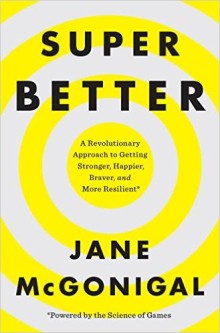 You remember Jane McGonigal, right? She’s the one who blends positive psychology with game design and hopes that a game designer will someday win a Nobel Prize. Her 2015 book SuperBetter extends that concept and explains, more or less, how to apply gamification to dealing with adversity and challenge.
You remember Jane McGonigal, right? She’s the one who blends positive psychology with game design and hopes that a game designer will someday win a Nobel Prize. Her 2015 book SuperBetter extends that concept and explains, more or less, how to apply gamification to dealing with adversity and challenge.
The concept, and the SuperBetter app that goes with it, came after McGonigal suffered a concussion from which she had great difficulty recovering. The first part of the book talks about positive psychology and video games, describing how video games are often helpful and healthy. The second section describes several rules for “being gameful†in your approach to challenges and all the other shit life can throw at you. Appropriately, these generally follow a video game motif, instructing you to adopt quests, seize power ups, and beat the bad guys.
Peppered all through this in asides and inserts are “Quests†where McGonigal asks you to take a moment to do something that illustrates what she’s talking about and increases some type of what she calls “resilience.†You may be asked to increase your social resilience by sending a kind note to someone, or improve your emotional resilience by looking out a window for a few minutes. Most of these little quests struck me as somewhat twee and goofy, but they seem pretty inseparable from the book’s methods and messages. The section of the book contains several applications of these quests and other lessons for specific “adventures†or things to do with the SuperBetter system. Think of them as playlists for particular moods or goals.
MgGonigal also inserts lots of “SuperBetter stories†into the chapters, which are testimonials and correspondences from SuperBetter users. I skimmed over all these, since they generally served to just repeat the lessons I had already read. I think they would have worked better if there were fewer of them and they had been incorporated directly into the main text.
Overall, I can see why this book is popular. The SuperBetter system is alluring and applicable to everyone, and apparently it works for at least some people. That’s awesome. McGonigal also has convivial style and seems like the kind of person you want cheering for you or helping you get through something tough –which is exactly what she does through this book. And I’m happy to say that despite the whole self-help aspect of the book and the eye rolling nature of some of the “quests,†McGonigal frequently drops some science by referencing proper research done at universities and published in peer reviewed scientific journals.
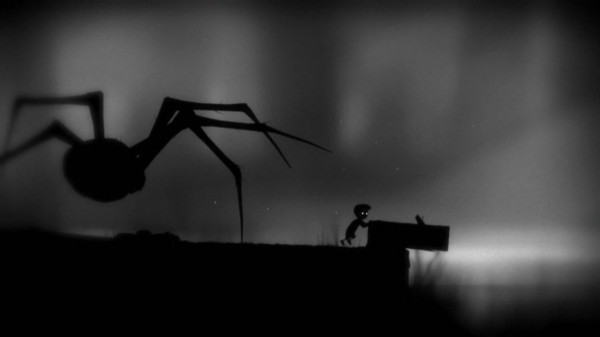


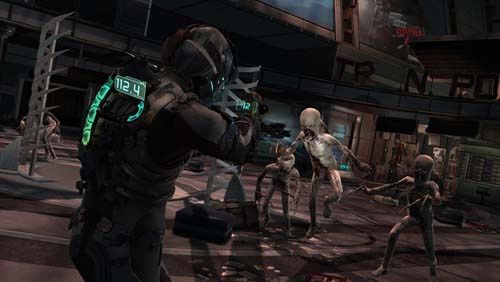

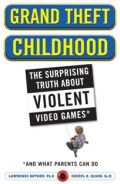 I came across Lawrence Kuthner and Cheryl Olson’s Grand Theft Childhood: The Surprising Truth about Violent Games (And What Parents Can Do) while doing some research for an article on
I came across Lawrence Kuthner and Cheryl Olson’s Grand Theft Childhood: The Surprising Truth about Violent Games (And What Parents Can Do) while doing some research for an article on 

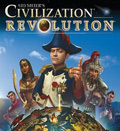
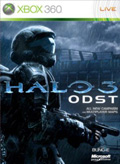
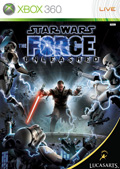

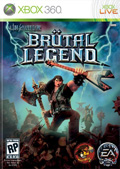

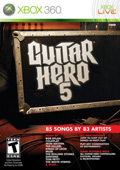 When GameFly sent me Guitar Hero 5 instead of all the other more exciting games ahead of it in my queue, I grimaced. Badly. Activision has been busily bloating the market with an exasperating number of entries in the fake plastic rock genre lately, what with Guitar Hero 5, Guitar Hero Metallica, Guitar Hero Van Halen, Band Hero, DJ Hero, and probably some others I’ve blocked out. And Harmonix hasn’t helped with Rock Band: The Beatles and Lego Rock Band.
When GameFly sent me Guitar Hero 5 instead of all the other more exciting games ahead of it in my queue, I grimaced. Badly. Activision has been busily bloating the market with an exasperating number of entries in the fake plastic rock genre lately, what with Guitar Hero 5, Guitar Hero Metallica, Guitar Hero Van Halen, Band Hero, DJ Hero, and probably some others I’ve blocked out. And Harmonix hasn’t helped with Rock Band: The Beatles and Lego Rock Band.
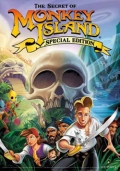 It’s one of my great shortcomings as a gamer that I never played any of the original Monkey Island adventure games released by Lucasarts in the 1990s. This is a shame, because those games and their
It’s one of my great shortcomings as a gamer that I never played any of the original Monkey Island adventure games released by Lucasarts in the 1990s. This is a shame, because those games and their  Spider: The Mystery of Bryce Manor was really my introduction to an iPod Touch game that had substantial production values and a price tag where the decimal point was somewhere besides the far left. It’s fantastic, really.
Spider: The Mystery of Bryce Manor was really my introduction to an iPod Touch game that had substantial production values and a price tag where the decimal point was somewhere besides the far left. It’s fantastic, really. The case (har har) of Phoenix Wright: Ace Attorney is an interesting one. It’s the first entry in what has become a long running series for the Nintendo DS (though the original game was actually on the Game Boy Advance in Japan) and even created a couple of spin offs. Calling it a “game” doesn’t quite describe it fully; I’d probably go with something closer to “interactive fiction” because anything where 98% of the gameplay is tapping anywhere on the screen to progress endless dialog boxes doesn’t seem like a game to me.
The case (har har) of Phoenix Wright: Ace Attorney is an interesting one. It’s the first entry in what has become a long running series for the Nintendo DS (though the original game was actually on the Game Boy Advance in Japan) and even created a couple of spin offs. Calling it a “game” doesn’t quite describe it fully; I’d probably go with something closer to “interactive fiction” because anything where 98% of the gameplay is tapping anywhere on the screen to progress endless dialog boxes doesn’t seem like a game to me. So this is a really alluring premise for a video game: solve a series of little environmental puzzles by conjuring almost any object you can think of and interacting with it in the game. That’s awesome! Who doesn’t get excited about a direct pipeline from his imagination to a video game? Here’s an example: an early level of Scribblenauts challenges you to get a cat down from the roof of a house and reunite it with its owner. Figure it out. Maybe you type in “W-I-N-G-S” or “L-A-D-D-E-R” and then give them to your in-game avatar Maxwell so that he can go up to retrieve the cat. Or you could lure the cat down with “F-I-S-H” or scare it down by plopping a “D-O-G” down next to it. Or whatever! You imagine it and Scribblenauts will let you create it and use it!
So this is a really alluring premise for a video game: solve a series of little environmental puzzles by conjuring almost any object you can think of and interacting with it in the game. That’s awesome! Who doesn’t get excited about a direct pipeline from his imagination to a video game? Here’s an example: an early level of Scribblenauts challenges you to get a cat down from the roof of a house and reunite it with its owner. Figure it out. Maybe you type in “W-I-N-G-S” or “L-A-D-D-E-R” and then give them to your in-game avatar Maxwell so that he can go up to retrieve the cat. Or you could lure the cat down with “F-I-S-H” or scare it down by plopping a “D-O-G” down next to it. Or whatever! You imagine it and Scribblenauts will let you create it and use it!
 Red Faction Guerrilla (RFG) is the latest in a series of shooters involving the liberation of Mars from a bunch of jerks. This third entry into the series mixes the formula up a bit, though. The first change is that RFG is an “open world” game where you can freely run or drive around, tackling missions at your leisure and constantly checking the map to figure out where the heck you are. This works well, even if Mars is a pretty boring and sterile place relative to the venues of other open world games.
Red Faction Guerrilla (RFG) is the latest in a series of shooters involving the liberation of Mars from a bunch of jerks. This third entry into the series mixes the formula up a bit, though. The first change is that RFG is an “open world” game where you can freely run or drive around, tackling missions at your leisure and constantly checking the map to figure out where the heck you are. This works well, even if Mars is a pretty boring and sterile place relative to the venues of other open world games.

